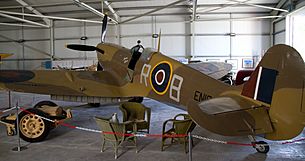Tony Lovell facts for kids
Quick facts for kids
Anthony Desmond Joseph Lovell
|
|
|---|---|
| Nickname(s) | Tony |
| Born | 9 August 1919 Ceylon |
| Died | 17 August 1945 (aged 26) Old Sarum, England |
| Buried |
Portrush Cemetery
|
| Allegiance | United Kingdom |
| Service/ |
Royal Air Force |
| Years of service | 1937–1945 |
| Rank | Wing Commander |
| Commands held | No. 244 Wing RAF (1943–44) No. 1435 Squadron RAF (1942–43) No. 145 Squadron RAF (1941–42) |
| Battles/wars | Second World War |
| Awards | Distinguished Service Order & Bar Distinguished Flying Cross & Bar Distinguished Flying Cross (United States) |
Anthony Desmond Joseph Lovell (born August 9, 1919 – died August 17, 1945) was a very brave fighter pilot. He was known as a "flying ace" in the Royal Air Force during World War II. He fought in major battles, including the Battle of Britain and the defense of Malta. Sadly, he died in a flying accident shortly after the war in Europe ended.
Contents
Early Life and Joining the RAF
Anthony Lovell was born in Ceylon (now Sri Lanka). His family later lived in Portrush, Northern Ireland. He was expected to become a priest, but after finishing school, he decided to join the Royal Air Force (RAF) instead. He joined the RAF in November 1937.
Flying in World War II
Lovell became a pilot officer in January 1938. He then joined No. 41 Squadron RAF in August 1938, where he flew Supermarine Spitfire fighter planes.
Battle of Britain Hero
In May 1940, Lovell helped destroy two German bombers over Dunkirk. On July 28, 1940, his Spitfire crashed after a fight near Dover. He was hurt but recovered. On September 5, 1940, his plane was shot down again over the Thames. He parachuted out safely.
In October 1940, he was put in charge of "B" Flight at RAF Hornchurch. He received the Distinguished Flying Cross on November 26, 1940. This award was for his courage and for shooting down seven enemy aircraft. His award citation said he showed "a fine fighting spirit" and led his team with "great courage, coolness and determination."
Fighting in the Middle East and Malta
In October 1941, Lovell took command of No. 145 Squadron RAF. He moved with his squadron to the Middle East in 1942. He was awarded a Bar to his Distinguished Flying Cross in February 1942. This was for being a "fearless and skilful fighter pilot." By then, he had personally destroyed at least 11 enemy planes.
In July 1942, Lovell went to Malta to join No. 603 Squadron RAF. Malta was under heavy attack by enemy aircraft. He soon took command of No. 1435 Flight RAF, which became a full squadron.
He earned the Distinguished Service Order on October 30, 1942, for his leadership during the Battle of Malta. He led his squadron against German bombers and their fighter escorts. In one fight, he shot down a Junkers Ju 88 bomber. His bravery helped defend Malta.
Later War Service
After a break, Lovell became an acting Wing Commander in 1943. He led No. 322 Wing RAF over Corsica and then No. 244 Wing RAF during the invasions of Italy and Southern France.
He received the American Distinguished Flying Cross in November 1944. His brother, Stuart, also serving in the RAF, was killed in action in 1944.
In February 1945, Lovell was awarded a Bar to his Distinguished Service Order. This was for his continued leadership as a fighter pilot. As the war ended, he was a chief flight instructor.
Lovell was a highly successful pilot. Experts say he destroyed 16 enemy aircraft and shared in the destruction of 6 others. He also damaged many more. He achieved this during five tours of duty.
Tragic End
On August 17, 1945, just after the war in Europe ended, Lovell was killed. He was performing aerobatics in a Spitfire plane near Old Sarum airfield when it crashed.


